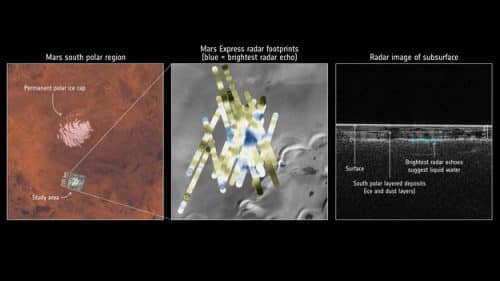Italian researchers who used the Mars Advanced Radar for Subsurface and Ionosphere Sounding - MARSIS installed on the European Space Agency's Mars Express spacecraft, identified a lake of liquid water that extends over an area 20 km wide at a depth of about one and a half kilometers under the ice layer

For decades, scientists have debated whether liquid water exists on Mars. On the surface this is not possible because in the thin atmosphere the water rises almost straight from ice to steam, but the hypothesis was that water could only exist in underground basins.
Italian researchers who used the Mars Advanced Radar for Subsurface and Ionosphere Sounding - MARSIS installed on the European Space Agency's Mars Express spacecraft, identified a lake of liquid water that extends over an area 20 km wide.
The MARSIS facility sends out radar pulses that penetrate the surface, including the layer of ice above it, and then measures the change in the radio waves when they are returned to the spacecraft. This method provides scientists with information about what lies beneath the surface.
Between May 2012 and December 2015, Roberto Orosi and his colleagues used MARSIS to survey an area called Planum Australe, located in the southern ice cap of Mars. They compared 29 arrays of radar samples (each such array maps an area in a certain observation). The mapping of the area showed a sharp change at a depth of 1.5 km below the surface of Mars, which is about 20 km wide.
The radar profile of this region is similar to that of lakes of liquid water found beneath the Antarctic and Greenland ice caps on Earth, suggesting that there is an underground lake at this location on Mars. Although the temperature in the area is supposed to be below zero degrees, the freezing point of pure water, Orosei and his partners estimated that minerals that are abundant in Martian rocks such as magnesium, calcium and sodium, may be dissolved in the water and make it salty. This salting with the pressure of the ice above, lowers the melting point, allowing the lake to remain in a liquid state, as it does on Earth.
"The subsurface anomaly on Mars has radar properties suitable for water or water-rich sediments," says Roberto Orosi, principal investigator of the MARSIS experiment and lead author of the paper published in the journal Science yesterday.
"We only explored one small area. It's exciting to think that there might be another pocket of underground water elsewhere on Mars waiting to be discovered."
"We've seen hints of interesting subsurface features for years, but we couldn't reproduce the result from one Mars Express lap to the next because the resolution was too low," says Andrea Cicchetti, director of MARSIS operations and co-author of the new paper.
We needed to improve the processing capability and sample at a higher rate, thereby improving the resolution of our data footprint. Now we see things that were simply not possible before."

The find is slightly reminiscent of Lake Vostok, which was discovered at a depth of about 4 km under the ice in Antarctica on Earth. There are life forms in subglacial habitats on Earth. Could the saltwater-rich underground pockets provide suitable habitat, now or in the past? The question of whether life existed on Mars remains open, and the answer is expected to be revealed in the next missions that will be launched to Mars, including the American-Russian spacecraft ExoMars, and future rovers that will continue to explore Mars.
"The long duration of Mars Express and the exhausting effort of the radar team to overcome many analytical challenges made this long-awaited result possible, demonstrating that the mission and its payload still have great scientific potential," says Dmitry Titov, Mars Express Project Scientist.
"This fascinating discovery is the highlight of the field of planetary science and will contribute to our understanding of the evolution of Mars, the history of water on our neighboring planet and the possible habitats there."
Mars Express was launched on June 2, 2003, and on December 25 this year it will celebrate 15 years in orbit around Mars.
More of the topic in Hayadan:

4 תגובות
In the end, it is about 2 water bodies that were forgotten there. love dramas
The probability is too low.
There were conditions there for the formation of organic life, this does not mean that there were. And they may have destroyed the planet as we are doing. Either they genetically modified, adapted, or seeded life elsewhere using small asteroids or these flew off on their own by a natural process. This is of course not scientific, but speculation at the level of what would have been. Then it is possible that life on Earth began from simple DNA molecules that adapted on their own to Earth's conditions.
After all, the probability of creating an RNA molecule is too great according to some researchers (not all) to be considered practical for the duration of the Earth, but when you multiply by the number of stars and their density during the time of the solar system, the chance increases significantly panspermia, but not in the alien sense, but a natural seeding of life.
It is written that the depth of the water "reservoir" is 1.5 km and its width is 20 km,
Now the reader is left to guess its area?